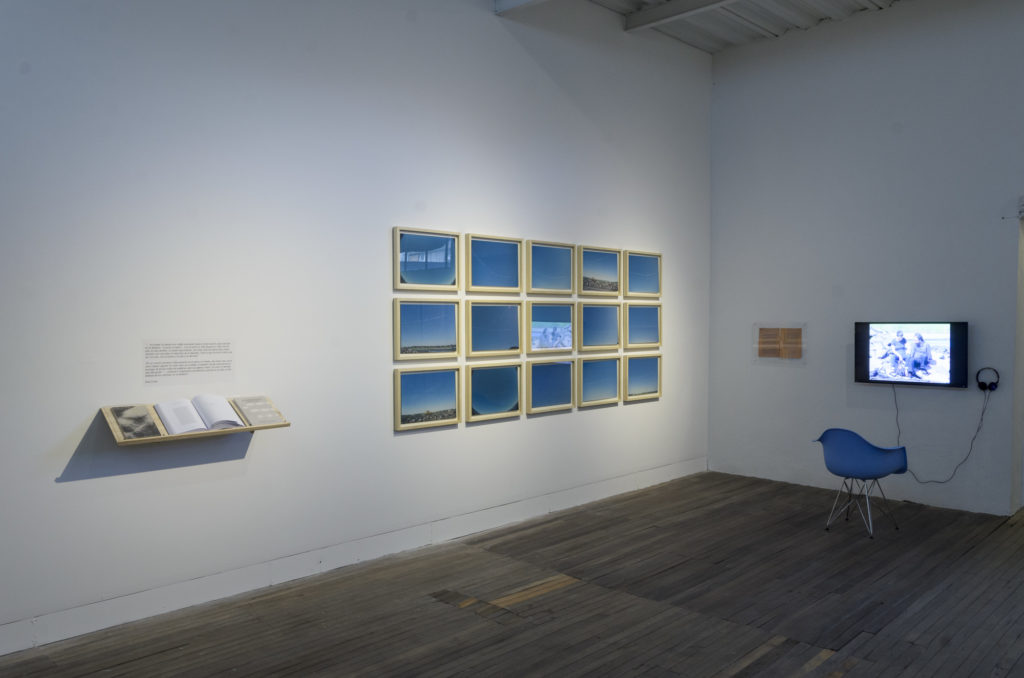Legible e ilegible
Las condiciones sociales y culturales que irrumpieron con el golpe militar del 11 de septiembre de 1973, hicieron que la sensibilidad y concepción del mundo se fracturaran para siempre. Para Raúl Zurita, a partir de dicho momento, la poesía se transformó en un refugio y única esperanza para superar la tragedia personal y colectiva del país, lo que implicaba, según ha referido, aprender a hablar de nuevo porque ninguno de los modelos poéticos y artísticos precedentes servían dar cuenta de la magnitud del quiebre histórico, político, psicológico, social, económico, que significó la implantación de la dictadura.
En julio de 1982 sobre Queens, Nueva York, escribió el poema “La Vida Nueva” mediante cinco aviones que lo iban trazando con letras de humo blanco que se recortaban contra el azul del cielo. El poema fue escrito en español como un homenaje a la población hispanoparlante de Estados Unidos: chicanos, latinos, y por extensión a los marginados y segregados de todas partes del mundo. Trazadas a 5 mil metros de altura, cada una de las 15 frases midió entre 5 y 7 kilómetros, por lo que fueron vistas desde amplios sectores de la ciudad. El artista visual Juan Downey hizo el registro fílmico de esta escritura y sus fotografías, fueron realizadas por Ana María López y Leonel Cid, formando parte del libro Anteparaíso, publicado en noviembre de ese año.
La presente edición, realizada por FLORA y el taller Arte Dos Gráfico, nos permite reencontrar los registros fotográficos de los poemas en el cielo acompañados por otras quince láminas en donde las frases han sido realizadas en cuño seco, y por lo tanto, a pesar de la nitidez tipográfica, el poema se hace legible en el surco del papel a través de la luz que hace evidente el bajo relieve.
Ni pena ni miedo, fue realizado el año 1993. A tres años del retorno a la democracia, Zurita concibió esta frase en el Desierto de Atacama. Con una extensión 3.5 kilómetros, y una caligrafía de silabario hispanoamericano, señaló una forma heroica de enfrentar el futuro, la esperanza y la tragedia. Cada palabra fue realizada con retroexcavadora y palas mecánicas, a una escala sólo posible de leer desde la distancia de un avión. El lector mira el suelo.
En la épica de Raúl Zurita, surge el proyecto de escritura sobre los acantilados. El año 2011 se publicó Zurita, y en las páginas finales 22 frases del poema Verás fueron inscritas en los inmensos acantilados que caen a pique en el mar. Estarán allí, sobrepuestas a los grandes paredones de la costa norte de Chile. La sola posibilidad, es el poema, esa es la obra: 22 frases monumentales que podrán ser leídas desde el horizonte, desde el mar. Frases que muestran lo que un ser humano ira viendo en su paso sobre la tierra. Para el poeta, esta obra debe ser hecha físicamente porque es la última resistencia del arte y de la vida contra la virtualidad.
Ramón Castillo, 2014
—
Raúl Zurita, Writing Material
Legible and illegible
The social and cultural conditions which busted into the military coup of September 11 1973, made the sensitivity and conception of the world break for ever. For Raúl Zurita, since this moment, the poetry transformed itselve into a refugium and only hope to overcome the personal and collective tragedy of the country. This implicates —according to what he referred— a new learning of how to speak because none of the poetic and artistic unpresendented models are usefull to report on the magnificant historic, politic, psycologic, social and economic loss, which means the implantation of the dictatorship.
In July 1982 the poem “La Vida Nueva” was written over Queens, New York through five airplanes drew letters of white smoke, which standed out against the blue sky. The poem was written in Spanish to pay homage to the hispanic population of the United States: chicanos, latinos and for the spreading of the marginalized and segregated of every part of the world. 5 Mil. meters high, every of the 15 sentences measured between 5 and 7 kilometers, so that they were visible from many parts of the city. The visual artist Juan Downey made a film register of this writings. His pictures, realized by Ana María López and Leonel Cid, are part of the book Anteparaíso, publiced in November this year.
The present edition, realized by FLORA and the workshop Arte Dos Gráfico allows us to find the foto registers of the poems in the sky, again. These were accompanied by other 15 plates where the pharses have been made of a dry stamp. Therefore, in spite of the typografic clearness, the poem becomes readable in the furrow of the paper: holding it against the light makes the low relief legible.
“Ni pena ni miedo” was realized in 1993. In the first 3 years back to democracy, Zurita conceived this frase in the Atacama Desert. With an extension of 3.5 kilometers and a calligraphy of a Hispanoamarican spelling book, it shows a heroic way of facing the future, the hope and the tragedy. Every word was made with old excavators and mecanic shovels, which only made it legible from the distance of an airplane. The reader looks at the soil.
In Raúl Zuritas epic, the writing project raises on the cliffs. In 2011 Zuritas 22 phrases of the poem “Verás fueron inscritas en los inmensos acantilados que caen a pique en el mar” were published. They will be seen on the top of the big walls of the nothern coast of Chile: 22 monumental phrases that will be readable from the horizon, from the sea. Phrases that show what a human being will see in its foodstep. For the poet, this work must be done physically because it is the last resistance of art and of life against the virtuality.
Ramón Castillo, 2014
